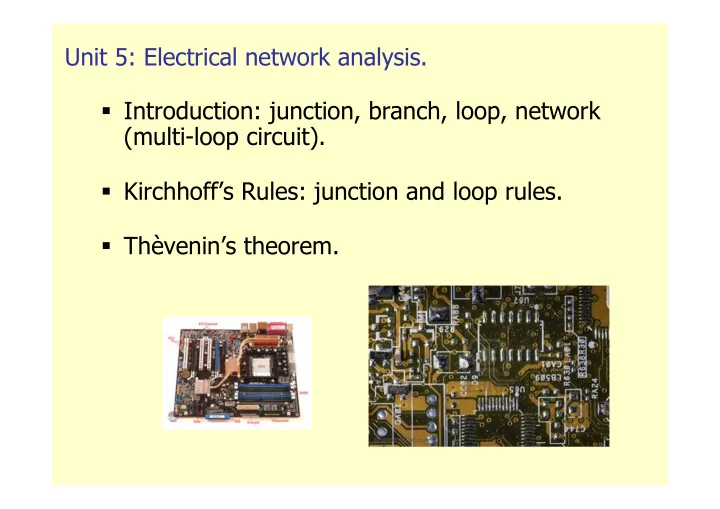

Unit 5: Electrical network analysis. Introduction: junction, branch, loop, network (multi-loop circuit). Kirchhoff’s Rules: junction and loop rules. Thèvenin’s theorem.
Introduction: definitions Electrical network: Set of interconnected dipoles (active and passive elements). If all the dipoles show linear ratios between V and I, the circuit is a linear network. V L R R R L V C C
Introduction: definitions Junction: point in the net where three or more wires are joined. Two junctions with the same potential are taken as the same junction. Network with three junctions: V L R R R L V C C These are the same junction
Introduction: definitions Branch: is the path having some device between two junctions. Electrical network with five branches: V L R R R L V C C This is not a branch
Introduction: definitions Loop: closed circuit with branches and no other loops inside. Electrical network with three loops: V L R R R L V C C
Kirchhoff’s Rules: Junction rule Junction Rule: The sum of the currents into the junction must be equal to the sum of the currents out of the junction. Algebraic addition = 0. This an expression of the charge conservation principle. I I 3 k I 2 I 0 = k I n I 1 Tipler, chapter 25, section 25.5
Kirchhoff’s Rules: Loop rule Loop rule: Algebraic sum of the changes in potential around a loop must be equal to zero. This an expression of the energy conservation principle. A point can not have two different potentials at once. V 1 1 2 V n V 2 V 0 = k n k V k Tipler, chapter 25, section 25.5
Application of Kirchoff’s rule To solve a circuit, we must write: (Junctions -1) equations of junction rule (Number of loops) equations of loop rule Example: 2 equations of junction rule + 3 equations of loop rule = 5 equations 5 unknown (intensities of current) L R V R R V L C C
Application of Kirchoff’s rule To solve a circuit, we must write: (Junctions -1) equations of junction rule (Number of loops) equations of loop rule Example: 2 equations of junction rule + 3 equations of loop rule = 5 equations 5 unknown (intensities of current) Junction 1: I I I − = 1 2 4 Junc 3 = Junc 1 + Junc 2 linearly depending Junction 2: I I I + = 2 5 3 Junction 3: I I I I I 2 I 3 + = + L 1 5 4 3 R 1 2 V I 1 R I 4 R L V I 5 C C 3
Thevenin’s theorem A linear active circuit with output terminals A and B is equivalent to a generator with e.m.f. equal to the difference in potential between A and B and an internal resistance equal to the equivalent resistance of the passive network (without ideal generators) between A and B. A A Linear R = R T eq B ≡ Active V ε = circuit T AB B It is easier to analyze circuits by splitting them into little pieces.
Recommend
More recommend